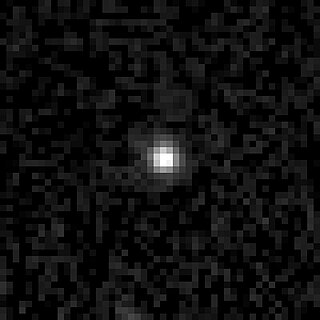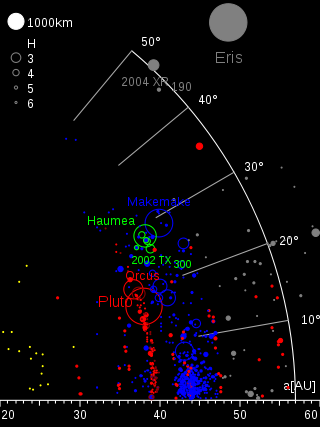
A classical Kuiper belt object, also called a cubewano ( "QB1-o"), is a low-eccentricity Kuiper belt object (KBO) that orbits beyond Neptune and is not controlled by an orbital resonance with Neptune. Cubewanos have orbits with semi-major axes in the 40–50 AU range and, unlike Pluto, do not cross Neptune's orbit. That is, they have low-eccentricity and sometimes low-inclination orbits like the classical planets.
In astronomy, the plutinos are a dynamical group of trans-Neptunian objects that orbit in 2:3 mean-motion resonance with Neptune. This means that for every two orbits a plutino makes, Neptune orbits three times. The dwarf planet Pluto is the largest member as well as the namesake of this group. The next largest members are Orcus, (208996) 2003 AZ84, and Ixion. Plutinos are named after mythological creatures associated with the underworld.

A trans-Neptunian object (TNO), also written transneptunian object, is any minor planet in the Solar System that orbits the Sun at a greater average distance than Neptune, which has an orbital semi-major axis of 30.1 astronomical units (au).

Makemake is a dwarf planet and the second-largest of what are known as the classical population of Kuiper belt objects, with a diameter approximately that of Saturn's moon Iapetus, or 60% that of Pluto. It has one known satellite. Its extremely low average temperature, about 40 K (−230 °C), means its surface is covered with methane, ethane, and possibly nitrogen ices.
(15874) 1996 TL66 (provisional designation 1996 TL66) is a trans-Neptunian object of the scattered disc orbiting in the outermost region of the Solar System.

(55565) 2002 AW197 (provisional designation 2002 AW197) is a classical, non-resonant trans-Neptunian object from the Kuiper belt in the outermost region of the Solar System, also known as a cubewano. With a likely diameter of at least 700 kilometers (430 miles), it is approximately tied with 2002 MS4 and 2013 FY27 (to within measurement uncertainties) as the largest unnamed object in the Solar System. It was discovered at Palomar Observatory in 2002.

10199 Chariklo is the largest confirmed centaur. It orbits the Sun between Saturn and Uranus, grazing the orbit of Uranus. On 26 March 2014, astronomers announced the discovery of two rings around Chariklo by observing a stellar occultation, making it the first minor planet known to have rings.

(55636) 2002 TX300 is a bright Kuiper belt object in the outer Solar System estimated to be about 286 kilometres (178 mi) in diameter. It is a large member of the Haumea family that was discovered on 15 October 2002 by the Near-Earth Asteroid Tracking (NEAT) program.

(208996) 2003 AZ84 (provisional designation 2003 AZ84) is a trans-Neptunian object with a possible moon located in the outer regions of the Solar System. It is approximately 940 kilometers across its longest axis, as it has an elongated shape. It belongs to the plutinos – a group of minor planets named after its largest member Pluto – as it orbits in a 2:3 resonance with Neptune in the Kuiper belt. It is the third-largest known plutino, after Pluto and Orcus. It was discovered on 13 January 2003, by American astronomers Chad Trujillo and Michael Brown during the NEAT survey using the Samuel Oschin telescope at Palomar Observatory.

(84922) 2003 VS2 is a trans-Neptunian object discovered by the Near Earth Asteroid Tracking program on 14 November 2003. Like Pluto, it is in a 2:3 orbital resonance with Neptune and is thus a plutino. Analysis of light-curve suggests that it is not a dwarf planet.
(24835) 1995 SM55 (provisional designation 1995 SM55) is a trans-Neptunian object and member of the Haumea family that resides in the Kuiper belt, located in the outermost region of the Solar System. It was discovered on 19 September 1995, by American astronomer Nichole Danzl of the Spacewatch program at Kitt Peak National Observatory near Tucson, Arizona, in the United States. It measures approximately 200 kilometers in diameter and was the second-brightest known object in the Kuiper belt, after Pluto, until 1996 TO66 was discovered.
(79983) 1999 DF9 (provisional designation 1999 DF9) is a trans-Neptunian object of the Kuiper belt, classified as a non-resonant cubewano, that measures approximately 270 kilometers in diameter.

(120178) 2003 OP32, also written as (120178) 2003 OP32, is a trans-Neptunian object (TNO) that resides in the Kuiper belt. It was discovered on July 26, 2003 by Michael E. Brown, Chad Trujillo and David L. Rabinowitz at Palomar Mountain in California.

(145453) 2005 RR43 (provisional designation 2005 RR43) is a trans-Neptunian object (TNO) estimated to be about 250 km in diameter. It was discovered on 9 September 2005 by Andrew Becker, Andrew Puckett and Jeremy Kubica at Apache Point Observatory in Sunspot, New Mexico.

(455502) 2003 UZ413 (provisional designation 2003 UZ413) is a trans-Neptunian object (TNO) with an absolute magnitude of 4.38. It is in a 2:3 orbital resonance with Neptune, thus it is classified as a plutino. There are indications it may be dense enough to be a dwarf planet. It was given the minor planet number 455502 on 22 February 2016.

The Haumea or Haumean family is the only identified trans-Neptunian collisional family; that is, the only group of trans-Neptunian objects (TNOs) with similar orbital parameters and spectra that suggest they originated in the disruptive impact of a progenitor body. Calculations indicate that it is probably the only trans-Neptunian collisional family. Members are known as Haumeids.
(55638) 2002 VE95 (provisional designation 2002 VE95) is a trans-Neptunian object from the outermost region of the Solar System. It was discovered on 14 November 2002, by astronomers with the Near-Earth Asteroid Tracking program at the Palomar Observatory in California, United States. This resonant trans-Neptunian object is a member of the plutino population, locked in a 2:3 resonance with Neptune. The object is likely of primordial origin with a heterogeneous surface and a notably reddish color (RR) attributed to the presence of methanol and tholins. It has a poorly defined rotation period of 6.8 hours and measures approximately 250 kilometers (160 miles) in diameter, too small to be a dwarf planet candidate. As of 2021, it has not yet been named.
(144897) 2004 UX10 (provisional designation 2004 UX10) is a Kuiper-belt object. It has a diameter of about 360 kilometres (220 mi) and was discovered by Andrew Becker, Andrew Puckett and Jeremy Kubica on 20 October 2004 at Apache Point Observatory in Sunspot, New Mexico. The object is classified as a cubewano. It is near a 2:3 resonance with Neptune.
(469306) 1999 CD158 (provisional designation 1999 CD158) is a trans-Neptunian object from the circumstellar disc of the Kuiper belt, located in the outermost region of the Solar System. The relatively bright hot classical Kuiper belt object measures approximately 310 kilometers (190 miles) in diameter. It was discovered on 10 February 1999, by American astronomers Jane Luu, David Jewitt and Chad Trujillo at Mauna Kea Observatories on the Big Island of Hawaii, United States.

(416400) 2003 UZ117 (provisional designation 2003 UZ117) is a trans-Neptunian object and suspected member of the Haumea family, located in the Kuiper belt in the outermost region of the Solar System. It was discovered on 24 October 2003, by astronomers of the Spacewatch survey project at Kitt Peak Observatory, Arizona. The object may also be a non-resonant cubewano.















